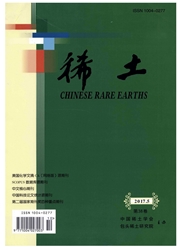

 中文摘要:
中文摘要:
以实验室熔炼制备的La(0.88)Mg(0.12)Ni(3.45)合金和商用AB5型合金为研究对象,利用形貌、物相、粒度和腐蚀电化学分析手段对比研究了两种合金在气固相和电化学吸放氢循环过程中的结构稳定性、粉化和腐蚀行为特征。结果表明,经过100次的气固相吸放氢试验,La(0.88)Mg(0.12)Ni(3.45)合金中除LaNi5相以外,其他相均发生了吸氢非晶化。氢致非晶化导致合金可逆吸放氢容量显著降低,并使合金吸氢初段的平台严重倾斜。La(0.88)Mg(0.12)Ni(3.45)合金循环后的粉化较轻,但合金中细小的(LaMg)Ni2相吸氢后较易剥落,导致部分小颗粒粒度频率的增加。商用AB5型合金循环后粒度降低更明显,但其粉化过程更为均匀。La(0.88)Mg(0.12)Ni(3.45)合金有更大的腐蚀热力学和动力学倾向,因此电化学循环后腐蚀更加严重。氢致非晶化和腐蚀是La(0.88)Mg(0.12)Ni(3.45)合金失效的主要原因。
 英文摘要:
英文摘要:
The phase stability,pulverization and corrosion behavior of as- made La(0.88)Mg(0.12)Ni(3.45) alloy after exposure to gas- solid cycling and electrochemical cycling were studied and compared with a commercial AB5 alloy through morphological analysis,particle granularity and electrochemical testing. The results indicate hydrogen- induced amorphization( HIA) occurs to all the phases except LaNi5 in the La(0.88)Mg(0.12)Ni(3.45) alloy after gas- solid cycling 100 times,which reduces the reversible hydrogen absorbing capacity dramatically and tilts the primary plateau of hydrogen absorbing severely. La(0.88)Mg(0.12)Ni(3.45) alloy after cycling shows better pulverization resistance,in which the(LaMg)Ni2 phase,however,becomes easily spalled after hydrogen absorption leading to an increase in particulation. After cycling the particle size of the commercial AB5 alloy reduces more extensively,but pulverization is more homogeneous. On the viewpoint of thermodynamics and electrochemistry,corrosion susceptance of La(0.88)Mg(0.12)Ni(3.45) alloy is very serious after electrochemical cycling. The hydrogen- induced amorphization and corrosion are testified to be the main reason on the failure of La(0.88)Mg(0.12)Ni(3.45) alloy.
 同期刊论文项目
同期刊论文项目
 同项目期刊论文
同项目期刊论文
 期刊信息
期刊信息
